Visitors to Alabama’s cascading waters are setting records
By Emmett Burnett
From gurgling brooks to raging rivers, we fall for waterfalls and there is probably one near you – Alabama has hundreds. Here are seven; some are famous, and others should be.
But first, heed advice from waterfall experts: If possible, call ahead and check conditions. During dry periods, some waterfalls cease falling. Another tip – safety first, as a waterfall is not a water park. It is nature. Be careful, obey the rules, have fun, starting with these:
Little River
The waterfalls of Little River Canyon are little only in name. Our search starts with Fort Payne’s big three: Little River Falls stands 45 feet high, and over centuries carved the canyon it inhabits. Second, Martha’s Falls is a mini-waterfall and a favorite swimming hole. Last and largest is the seasonal (not often flowing in summer) Grace’s High Falls, 133-feet high, the tallest waterfall in Alabama.
Height is not the only record Little River Canyon and falls have set. Attendance is setting records. “2020 was our biggest year ever,” recalls the site’s superintendent, Steve Black. “Last year we brought in about 800,000 visitors. That’s about a 100,000 increase over 2019.”
The most popular of the three is the namesake, Little River Falls, easily accessible by foot. Visitors tread boardwalks splitting into two routes. One is for people with difficulties maneuvering down steps. The other route leads hikers along scenic-rocky paths.
The other two falls also await explorers. The trek is a bit longer to the overlooks, but the jaw-dropping vistas are worth the hike.
But before assuming Daniel Boone mode, take note: During peak flow times, usually winter or after heavy rain, the timid becomes a tempest. Stay at least 50 feet from the turbulent waterfalls’ edges (required by law). One misstep could send you over the falls, becoming one with nature.
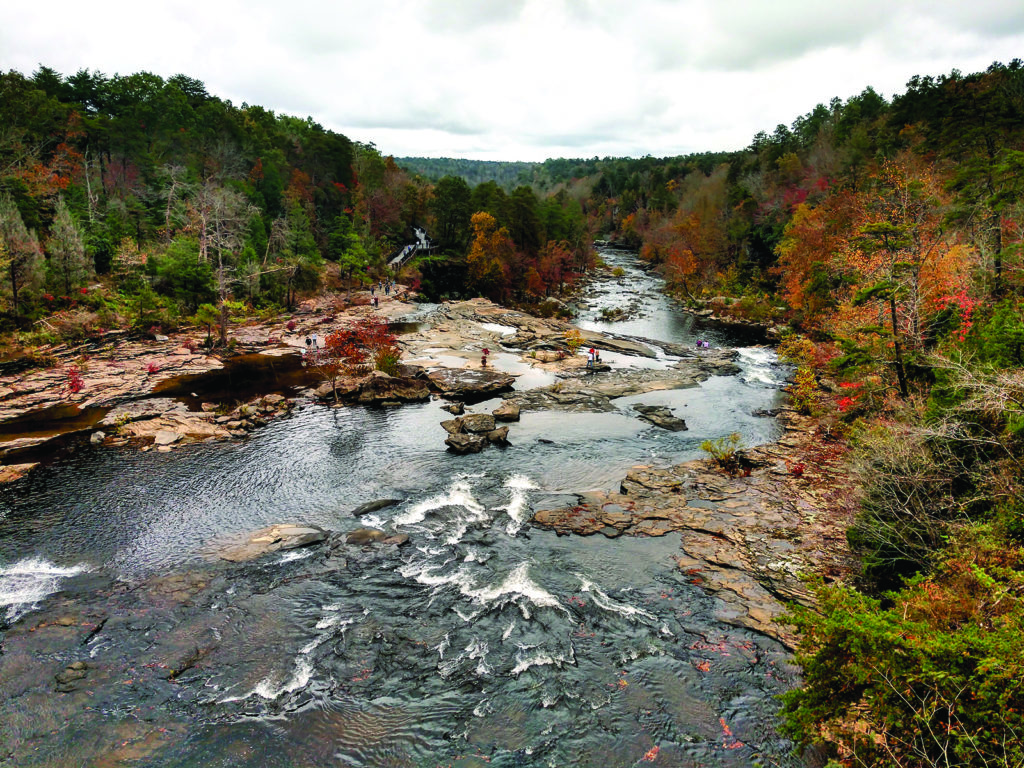
Noccalula Falls
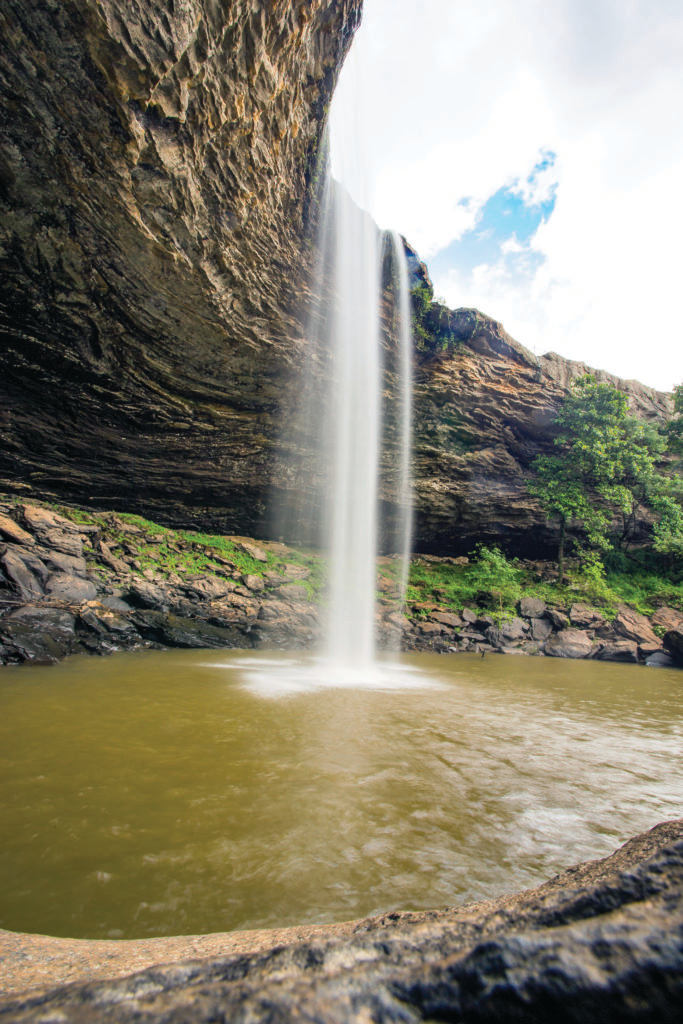
Photo submitted by Christina Richardson
A city showpiece, Gadsden’s waterfall namesake has a heart-tugging tale. Legend says Noccalula was a young Indian maiden in love with a local brave. Her father disapproved. Dad promised his daughter to another suitor in a neighboring tribe.
Rather than marry someone she did not love, Noccalula leaped to her death into the waterfall. Her statue stands atop the fall, depicting the event.
But on a happier note, more than 200,000 people visit Noccalula Falls annually. “It is popular because of easy access and it is beautiful, and offers a one-of-a-kind experience,” notes Christina Richardson, Noccalula Falls supervisor for the city of Gadsden. “In addition to viewing, you can hike behind the waterfall.”
Noccalula Falls is packed with entertainment venues. The 500 acres includes a train ride, pioneer village, botanical garden, campground, 18-hole mini golf course, a playground, and 15 miles of hiking, biking, and running trails. Unfortunately, the petting zoo suffered a devastating fire on May 2, and many of the animals were lost. As of press time, the Gadsden Fire Department is investigating the cause of the blaze.
Meanwhile, the statue of Noccalula gazes down the 90-foot column of rushing water. While teetering on the waterfall’s ledge, her likeness teaches us a lesson in love: Look before you leap.
DeSoto Falls
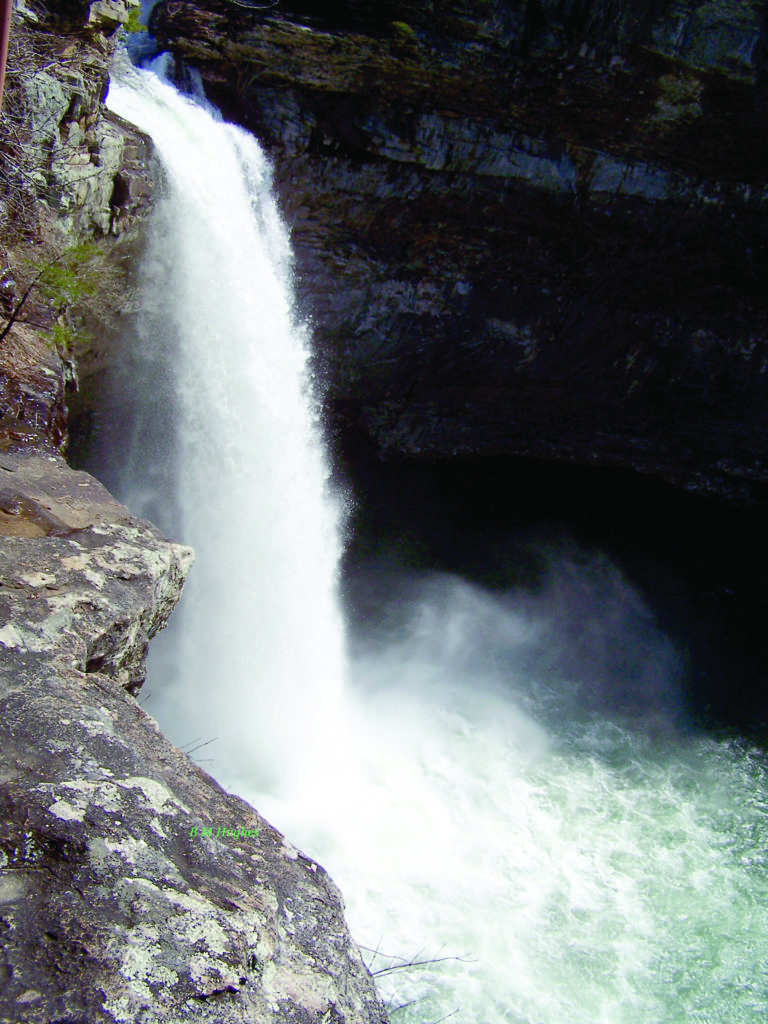
One of Alabama’s largest and most visible, DeSoto Falls cascades over the A.A. Miller Dam before pouring 90 feet into a gorge below. Pro tip: DeSoto Falls is one of many waterfalls in DeSoto State Park. “Many people don’t realize DeSoto Falls is one piece of the park’s 3,580 acres,” says Brittney M. Hughes, park naturalist. “There are falls galore most of the year in the main park area as well.”
DeSoto Falls is one of Alabama’s most popular tourist destinations. “To avoid crowds, visit during the winter. That would be your best bet,” Hughes says. “The busiest times for the picnic area are summer and fall weekends. If you visit during those times, go in the early morning or late afternoon.”
In addition to picnicking, DeSoto Falls and DeSoto State Park feature guided paddle trips, kayak rental, zip lining, fishing, and mountain biking. However, as stated in their website, kayaking over the falls is not permitted.
For those desiring to paddle a personal watercraft over a 107-foot wall of water, seek elsewhere. Also seek help. There’s got to be a cure.
Moss Rock Preserve and Falls
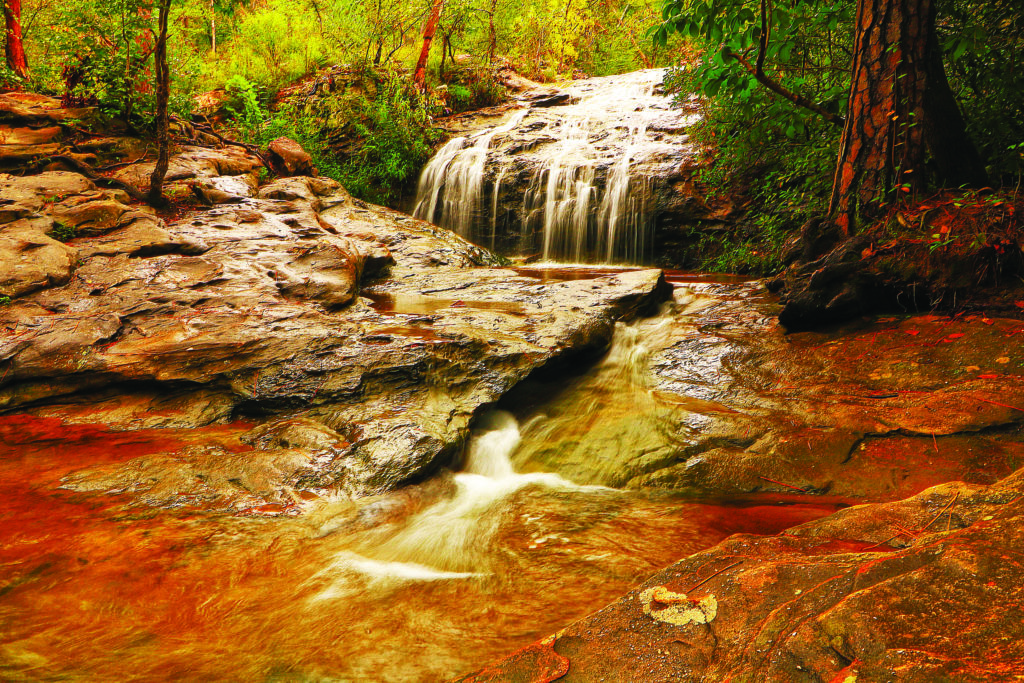
“Are you kidding me?” explorers often say on their first visit. “This is not a city park.” Yes, it is, but not just any city park. Moss Rock Preserve and Falls might be the best kept secret in Hoover. Hiking, rock climbing, rare plants, and waterfalls are nestled in 349 acres within Hoover City Limits. The secret is out.
“It is great for an afternoon hike or all-day adventure,” says Hoover resident and photographer, Ty Evans. “It has good trails, easy to walk, and not far from the parking area. Lots of local residents park and hike for a quick retreat or long lunch break.”
Others stay longer. Ken Wills is president of Friends of Moss Rock Preserve. “The preserve has rare plants, which change colors – golds and deep blues – with the changing seasons. It’s beautiful,” he says. “As for the falls, the middle of winter to late spring usually results in the best water flow.”
Chewacla State Park
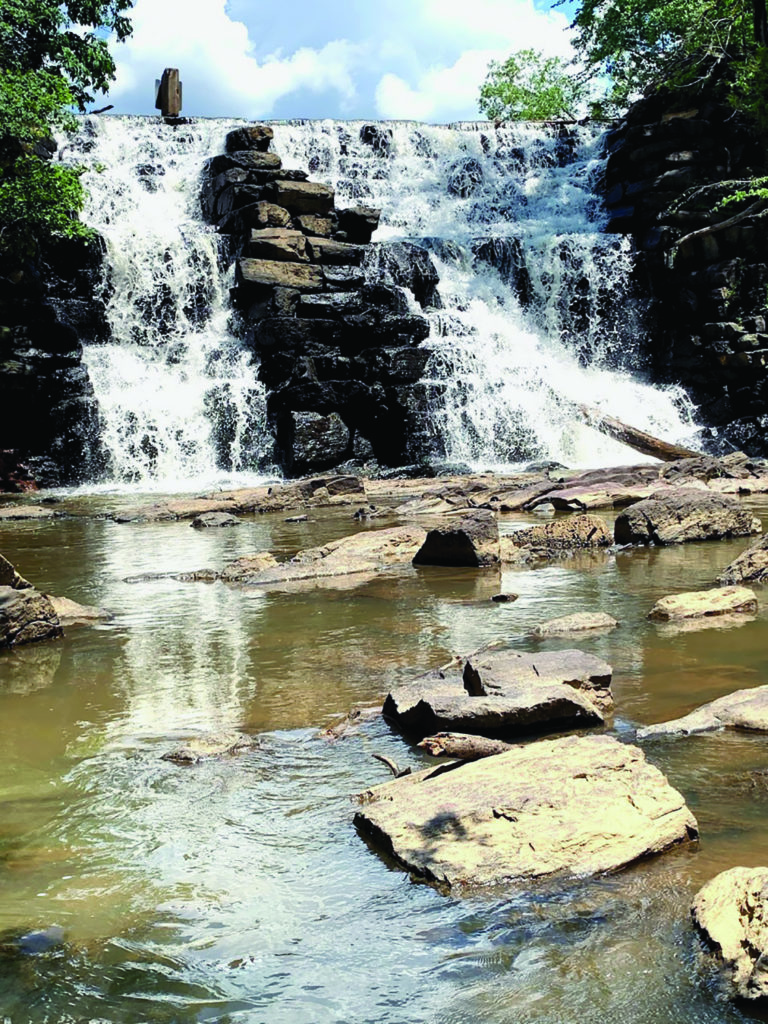
Something doesn’t feel right at Chewacla State Park. Oh, it feels good – hiking forest trails and climbing rocks at the foot of a cascading waterfall. But it doesn’t feel like this 696-acre wilderness is 15 minutes from downtown Auburn.
It is.
“I can have a fancy meal at one of Auburn’s fine restaurants or attend an Auburn University sporting event and within 15 minutes, be back here. It does not feel like you are so close to town,” Park Manager Joshua Funderburk says.
Chewacla’s waterfalls include natural and man-made. A most popular natural one is around 20 feet tall. It is one of the smaller tributaries in our list which allows a more up close and personal experience.
The trails to and from the scenic falls include a 26-acre lake, swimming areas, birdwatching, forest walking, rustic camping to easy living cabins with electricity and TV.
About 30 miles of hiking and biking trails are available including paths leading to the falls. Chewacla offers the best of both worlds: A wilderness wonderland six miles from Jordan Hare Stadium.
Dismals Canyon Rainbow Falls
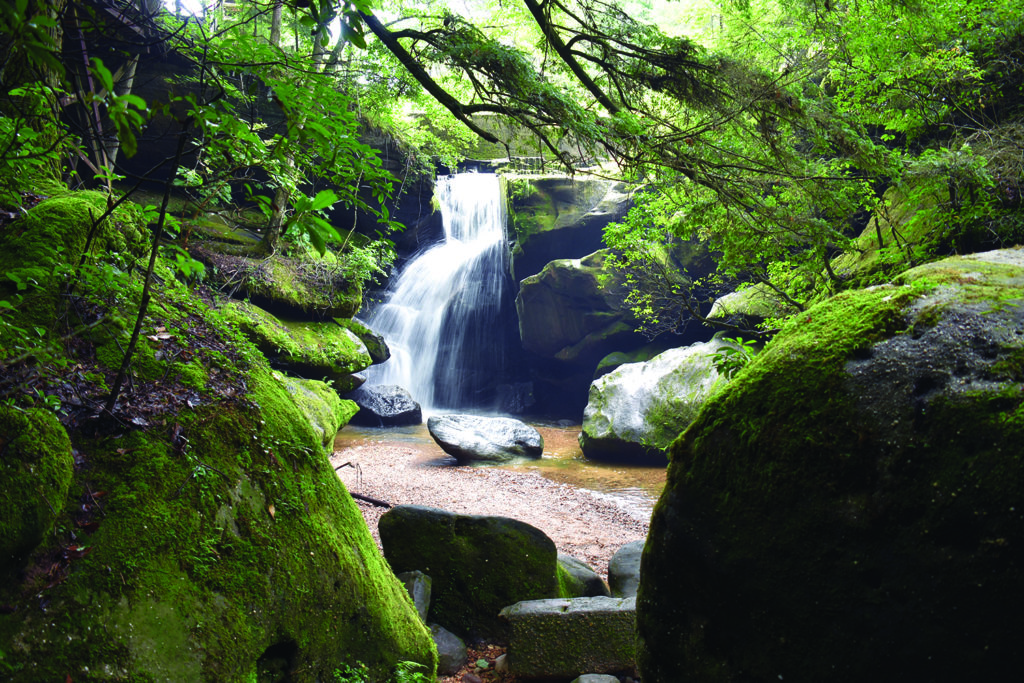
Quite simply one of the most eerily beautiful places I have seen. You descend the Phil Campbell, Alabama, canyon by stairway. Almost immediately you hear the sound of roaring water and then, wow, there it is. Under a canopy of jungle-like trees, framed by minivan-size boulders is Rainbow Falls.
Sprays bouncing off the prehistoric tributary project rainbows in the mist. Hence the name, “Rainbow Falls.” The vista is accompanied by visitors’ oohs and ahhs. For a moment in time we forget about COVID-19. God is in control and He loves color.
Other falls cascade down mammoth rocks throughout the canyon too. Camping and cabins are available and so is a restaurant and gift shop. Plan on spending the morning or afternoon to fully explore. Rainbow Falls’ creation took a million years. You can spare three hours.
Mardis Mill Falls

The final venture is a little waterfall hidden off 546 Mardis Mill Road in Blountsville. Mardis is not famous like state neighbors Noccalula and DeSoto. Nor is it a big waterfall, about 35 feet wide, the width on Grave’s Creek. The falls’ water pours down 16 feet.
“But it is a beautiful, restful place,” adds Ty Evans. “Just park and walk a short trail.”
Nearby are various covered bridges, including Horton Mill Bridge, built in 1935. At 70 feet above Little Warrior River’s feeder bends, it is the highest covered bridge above a waterway in the U.S. Save the bridge for last. Visit Mardis Falls first.
Like the other six, Mardis Mill Falls pleases the eye, lifts our spirits, and calms wayward blood pressure.




